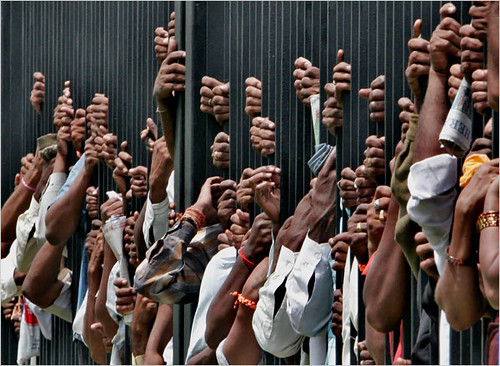of Steel and Bone

[Image: Photo: Aijaz Rahi/Associated Press, New York Times, 2008.]
Spotted a powerful image in the New York Times the other day. Intriguing to me is this anonymous chain of arms and hands seeping through the fence, a fence equally anonymous, and a scene that perhaps could be found dispatched at so many different coordinates around the world.
It may not be intentional, but the way the photo reduces humanity to a random assembly of arms and hands detached from any bodies casts an effective portrayal of how refugees and migrants are perceived and treated by national governments in the current geopolitical climate. As if the detained, or even those just enclosed – more so, those who have been disenfranchised – aren’t even seen as full bodied human beings, but as an excess of ‘othered’ limbs seeking to worm their way past the wrought iron gates, resting their tired elbows and emptied hands before recocking them towards some sort of handout. I wonder, though, if this image of bare-knuckled laborers provides an accurate critique of how the media distorts representations of the world’s excluded populations, or whether it is merely another dehumanizing consequence of the media?
Either way, I find something subtly revolutionary in this photo – a suggestion that fences alone wont stop the power of unwanteds or completely shun them out from finding their spaces in or through the gaps. There is a solidarity in these arms lurking below the depiction of the fence as being able to hold back a mob, that symbolizes how – not only is the border fence itself forged equally of bone and steel – but the human connections interwoven in the border are far more powerful than any bolted or welded barricade. To not see this human side is to accept then that the humanity in this photo is simply just another piece of the fence itself, as if body parts are an acceptable supplemental materiality in the composition of the barrier.
Of course, I am reading too much into this, or just trying to.
But, one might wonder from this image if the barricade is held in place by itself or by the anonymous set of hands holding onto it. While it may be defense contractors who are responsible for building these fences along the border, is it the hands of the laborers themselves who actually keep the fence in place? Is this irony brought into light by the photo? Could it be that border fences are not only made to prevent the flow of illegal migrant workers, but they are also made and preserved by them? Remember the stories of the Palestinian workers who built massive sections of the Israeli separation wall in the West Bank, and the San Diego fence company who was busted for employing illegal migrant workers to install a portion of the fence on the Mexican border? Are the migrants being forced to sell out their freedom to movement by building the obstructions to their own betterment on the other side? Is this photo suggesting that the fence builders and the migrants are somehow both responsible for propping up these types of walls?
From the photo alone we really have little idea of what the circumstances are: a refugee camp, a border fence, a prison…? Regardless, it is curious how the hands themselves are what seem to be witnessing the event taking place on the other side, as if the hands are the looking glasses of the poor. I get the feeling at any moment these same hands are going to not only grab the fence but rip it down, and that for every barrier that stands upright across the landscape of global migration, there is a set of arms or forceful fingers, waiting to test its strength in the ground. Looking at this image I sense that despite the fence the arms of the global south aren’t waiting or reaching for hand outs (as the media might have us believe) but striving for the right to their own opportunity, and with their own presence and equal determination to those who seek to block them will somehow manage to get through.







2 Comments:
Hey Brian,
Is there a way to email you without creating a log in on that other page?
Anyway here a news story that seems to be evidence of transplanting the urban control measures we've developed in Iraq here to the US. No blast walls have been put up yet, but:
"DC Police announced a military-style checkpoint yesterday to stop cars this weekend in a Northeast Washington neighborhood inundated by gun violence..."
http://www.washingtonpost.com/wp-dyn/
content/article/2008/06/04/
AR2008060402205_pf.html
dan
thanks for the link, we live in the age of the checkpoint, that's for sure.
subtopia dot blog / google mail
Post a Comment
<< Home